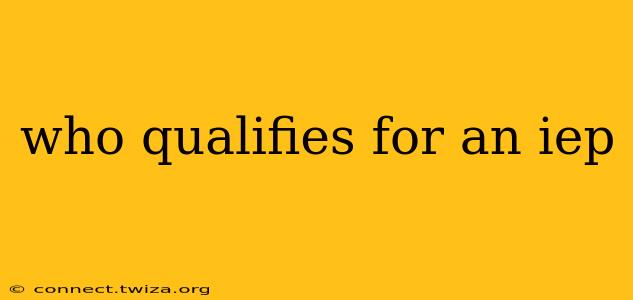Navigating the world of special education can be challenging, especially when trying to understand who qualifies for an Individualized Education Program (IEP). This comprehensive guide will break down the eligibility criteria, addressing common questions and concerns. Remember, this information is for general understanding and should not be considered legal advice. Always consult with your child's school district for specific procedures and requirements.
What is an IEP?
Before diving into eligibility, let's define what an IEP is. An Individualized Education Program (IEP) is a legally binding document outlining the specific educational needs of a student with a disability and the supports and services required to help them succeed in school. It's a collaborative effort involving parents, educators, and other relevant professionals.
Who Qualifies for an IEP? The Key Criteria
A student qualifies for an IEP if they meet specific criteria outlined by the Individuals with Disabilities Education Act (IDEA). These criteria generally include:
-
A Disability: The student must have one or more disabilities as defined by IDEA. This covers a wide range of impairments, including:
- Specific Learning Disabilities (SLDs): These affect a student's ability to learn in specific areas like reading, writing, or math, despite having average or above-average intelligence.
- Speech or Language Impairments: Difficulties with articulation, fluency, voice, language comprehension, or use.
- Intellectual Disabilities: Significant limitations in both intellectual functioning and adaptive behavior.
- Emotional Disturbance: A condition exhibiting characteristics like inability to learn, inability to build or maintain relationships, inappropriate types of behavior or feelings under normal circumstances, pervasive mood of unhappiness or depression, and physical symptoms or fears associated with personal or school problems.
- Autism Spectrum Disorder (ASD): Characterized by challenges with social interaction, communication, and repetitive behaviors.
- Traumatic Brain Injury (TBI): Impairment resulting from an injury to the brain.
- Other Health Impairments: Limiting conditions such as ADHD, diabetes, epilepsy, or asthma that significantly affect educational performance.
- Visual Impairments: Including blindness and low vision.
- Deafness and Hearing Impairments: Including deafness, hard of hearing, and hearing loss.
- Orthopedic Impairments: Physical limitations affecting mobility and/or dexterity.
- Multiple Disabilities: Two or more disabilities that result in such severe educational needs that they cannot be accommodated in special education programs solely designed for one of the impairments.
- Developmental Delay: For preschool children, a significant delay in one or more developmental areas (physical, cognitive, communication, social-emotional, adaptive).
-
Need for Special Education Services: The student's disability must significantly affect their educational performance. This means the disability interferes with their ability to access and make progress in the general education curriculum. It's not enough to simply have a diagnosis; the disability must impact their learning.
-
Documentation: The school needs comprehensive documentation to support the student's eligibility. This often involves evaluations conducted by professionals like psychologists, speech-language pathologists, and educational specialists.
How is Eligibility Determined?
The process generally involves:
- Referral: A parent, teacher, or other school personnel can initiate a referral for an evaluation.
- Evaluation: A comprehensive evaluation is conducted to determine if the student meets the eligibility criteria.
- Eligibility Meeting: A team, including parents, educators, and specialists, reviews the evaluation results and decides whether the student is eligible for special education services.
- IEP Development: If the student is eligible, an IEP team develops an individualized plan outlining the specific services and supports they will receive.
What if My Child Doesn't Qualify for an IEP?
If your child doesn't meet the criteria for an IEP, they may still be eligible for other support services, such as:
- 504 Plan: A 504 plan provides accommodations to address a student's disability that significantly impacts their learning. Unlike an IEP, it doesn't require specialized instruction.
- Response to Intervention (RTI): RTI is a tiered approach to providing support to students who are struggling academically or behaviorally. It involves providing increasingly intensive interventions before determining whether special education is needed.
Frequently Asked Questions (FAQs)
How long does the IEP process take?
The timeframe varies, but it can generally take several weeks to months, depending on the complexity of the case and the availability of evaluators.
Can my child be removed from an IEP?
Yes, a student can be removed from an IEP if their needs no longer require special education services. This typically involves a reevaluation process.
What if I disagree with the IEP?
You have the right to challenge the IEP and request a due process hearing.
Are there different types of IEPs?
While the fundamental purpose remains the same, the content and specifics of an IEP will vary depending on a child's unique needs and identified disability.
This information provides a general overview. The specific processes and requirements for IEP eligibility can vary by state and school district. It's crucial to actively participate in the process and work closely with your child's school team to ensure their needs are met. Remember to always consult with your school district's special education department for personalized guidance and support.
